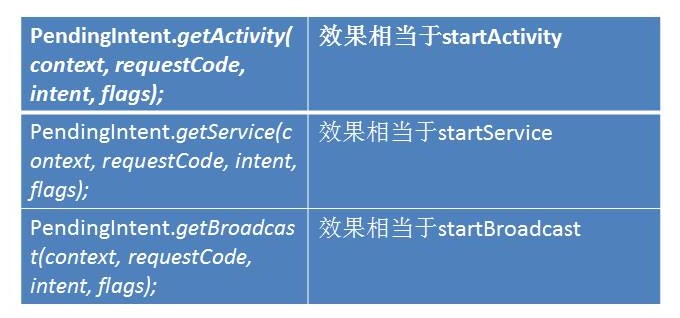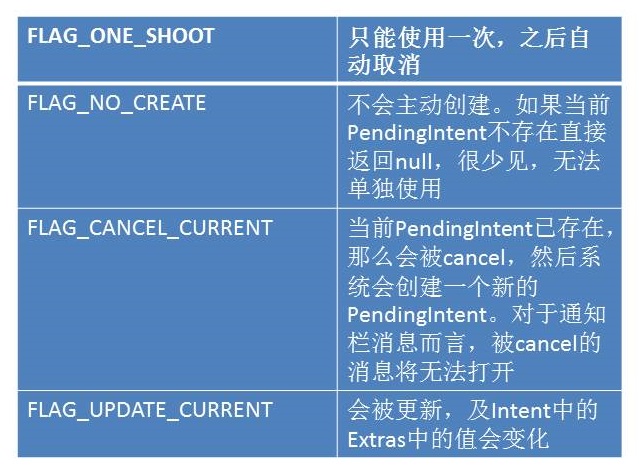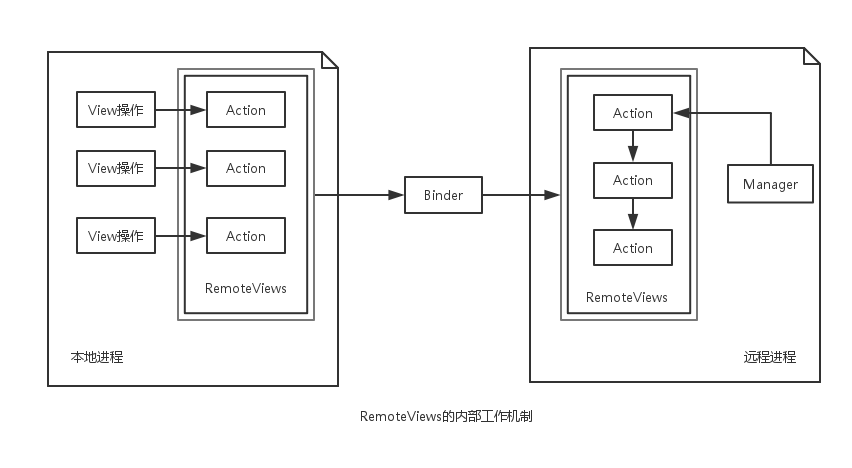使用方法我就不介绍了,网上一大堆
1.PendingIntent概述
PendingIntent表示在将来的某个时刻发生,Intent是立即发生。
PendingIntent的匹配规则:如果两个PendingIntent它们内部的Intent相同并且requestCode也相同,那么这两个PendingIntent就是相同的(如果两个Intent的ComponentName和intent-filter都相同,那么这两个Intent就是相同的,Extras不参与Intent匹配)。
PendingIntent支持三种待定意图
第一个和第三个参数好理解,第二个参数requestCode表示PendingIntent发送方的请求码,通常为0.另外requestCode会影响后面flag的取值。
flag有如下取值:
2.RemoteViews的内部机制
进入源码
class RemoteViews implements Parcelable, Filter它实现了Parcelable接口,显然和跨进程通信有关
然后看一下最常用的构造方法
public RemoteViews(String packageName, int layoutId)packageName表示当前应用的包名
layoutId对应的布局文件
RemoteViews只支持如下类型
Layout:
FrameLayout,LinearLayout,RelativeLayout,GridLayout
View:
AnalogClock,Button,Chronometer,ImageButton,ImageView,ProgressBar,TextView,ViewFlipper,ListView,GridView,StackView,AdapterViewFlipper,ViewStub首先讲讲内部实现机制
通知栏和桌面小部件分别由NotificationManager和AppWidgetManager管理。而NotificationManager和AppWidgetManager通过binder分别和SystemServer进程中的NotificationManagerService和AppWidgetService进行通信。由此可见通知栏和桌面小部件是在NotificationManagerService和AppWidgetService被加载,然后运行在SystemServer中
首先RemoteViews通过Binder传递到SystemServer中(实现了Parcelable接口,可以跨进程传输)。系统根据包名得到资源,然后通过layoutinflater加载布局文件。(在SystemServer算一个普通的view,而在我们的进程中算RemoteViews)然后会有一系列set方法更新view,但不会立即执行,而是会保存下来,直到RemoteViews被加载以后再执行。
理论上来讲,系统可以让binder直接支持所有操作,但是大量IPC操作会影响效率
由于RemoteViews是在远程进程中显示,所以无法用findviewbyid,通常用set方法,比如setTextViewText()。接下来看一下它的源码
public void setTextViewText(int viewId, CharSequence text) {
setCharSequence(viewId, "setText", text);
}再看一下setCharSequence源码
public void setCharSequence(int viewId, String methodName, CharSequence value) {
addAction(new ReflectionAction(viewId, methodName, ReflectionAction.CHAR_SEQUENCE, value));
}再看一下addAction源码
private void addAction(Action a) {
if (hasLandscapeAndPortraitLayouts()) {
throw new RuntimeException("RemoteViews specifying separate landscape and portrait" +
" layouts cannot be modified. Instead, fully configure the landscape and" +
" portrait layouts individually before constructing the combined layout.");
}
if (mActions == null) {
mActions = new ArrayList<Action>();
}
mActions.add(a);
// update the memory usage stats
a.updateMemoryUsageEstimate(mMemoryUsageCounter);
}这下可以看到里面有一个ArrayList专门用来存储Action的。但是显然现在只是把Action保存起来,并没有对view进行实际操作啊。之前说过了“会保存下来,知道RemoteViews被加载以后再执行”
接下来看一个apply函数
public View apply(Context context, ViewGroup parent, OnClickHandler handler) {
RemoteViews rvToApply = getRemoteViewsToApply(context);
View result;
final Context contextForResources = getContextForResources(context);
Context inflationContext = new ContextWrapper(context) {
@Override
public Resources getResources() {
return contextForResources.getResources();
}
@Override
public Resources.Theme getTheme() {
return contextForResources.getTheme();
}
};
LayoutInflater inflater = (LayoutInflater)
context.getSystemService(Context.LAYOUT_INFLATER_SERVICE);
inflater = inflater.cloneInContext(inflationContext);
inflater.setFilter(this);
result = inflater.inflate(rvToApply.getLayoutId(), parent, false);
rvToApply.performApply(result, parent, handler);
return result;
}apply先加载resources,然后解析remoteview的布局,最后调用performApply
private void performApply(View v, ViewGroup parent, OnClickHandler handler) {
if (mActions != null) {
handler = handler == null ? DEFAULT_ON_CLICK_HANDLER : handler;
final int count = mActions.size();
for (int i = 0; i < count; i++) {
Action a = mActions.get(i);
a.apply(v, parent, handler);
}
}
}可以看到,这里才是对view的真正操作

























 1509
1509

 被折叠的 条评论
为什么被折叠?
被折叠的 条评论
为什么被折叠?








